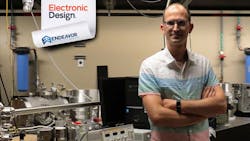This article appeared in Electronic Design and has been published here with permission.
What you’ll learn:
- The issues with high-speed optical signals.
- A solution for real-time measurement.
- Information on the team that developed it.
A team from the University of Central Florida (UCF) has developed the world’s first optical oscilloscope, an instrument that’s able to measure the electric field of light. The device converts light oscillations into electrical signals, much like hospital monitors convert a patient’s heartbeat into electrical oscillation.
Until now, reading the electric field of light has been a challenge because of the high speeds at which light waves oscillate. The most advanced techniques can currently clock electric fields at up to gigahertz frequencies, covering the radio-frequency and microwave regions of the electromagnetic spectrum.
However, the current tools for measuring light fields could resolve only an average signal associated with a “pulse” of light, and not the peaks and valleys within the pulse. Measuring those peaks and valleys within a single pulse is important because it’s in that space that more information can be packed and delivered.
“Fiber-optic communications have taken advantage of light to make things faster, but we are still functionally limited by the speed of the oscilloscope,” says Physics Associate Professor Michael Chini, who worked on the research at UCF. “Our optical oscilloscope may be able to increase that speed by a factor of about 10,000.” The team’s findings are published in the Nature Photonics journal.
The team developed the device and demonstrated its capability for real-time measurement of the electric fields of individual laser pulses in Chini’s lab at UCF. The next step for the team is to see how far they can push the speed limits of the technique.
The lead author of the paper is UCF postdoctoral scholar Yangyang Liu. Other authors include physics alums Jonathan Nesper ’19 ’21MS, who earned his bachelor’s in math and master’s in physics; Shima Gholam-Mirzaei ’18MS ’20PhD; and John E. Beetar ’15 ’17MS ’20PhD.
Gholam-Mirzaei is now a postdoctoral researcher at the Joint Attosecond Science Laboratory at the National Research Council of Canada and University of Ottawa. Beetar is completing a postdoc at the University of California at Berkeley.
Chini had the idea for the single-shot waveform measurement scheme and oversaw the research team. Liu led the experimental effort and performed most of the measurements and simulations. Beetar assisted with the measurements of the carrier-envelope phase dependence. Nesper and Gholam-Mirzaei assisted with the construction of the experimental setup and with the data collection. All authors contributed to the data analysis and wrote the journal article.

